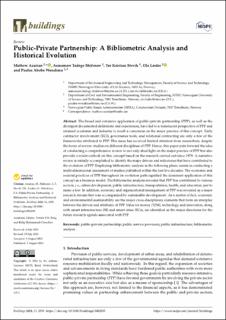| dc.contributor.author | Azarian, Mathew | |
| dc.contributor.author | Shiferaw, Asmamaw Tadege | |
| dc.contributor.author | Stevik, Tor Kristian | |
| dc.contributor.author | Lædre, Ola | |
| dc.contributor.author | Wondimu, Paulos Abebe | |
| dc.date.accessioned | 2023-11-01T07:56:54Z | |
| dc.date.available | 2023-11-01T07:56:54Z | |
| dc.date.created | 2023-08-10T11:58:45Z | |
| dc.date.issued | 2023 | |
| dc.identifier.citation | Buildings. 2023, 13 (8), 1-24. | en_US |
| dc.identifier.issn | 2075-5309 | |
| dc.identifier.uri | https://hdl.handle.net/11250/3099893 | |
| dc.description.abstract | The broad and extensive application of public-private partnership (PPP), as well as the divergent documented definitions and experiences, have led to a translucent perspective of PPP and strained academia and industry to reach a consensus on the major practice of this concept. Early contractor involvement (ECI), governance tools, and relational contracting are only a few of the frameworks attributed to PPP. This issue has received limited attention from researchers, despite the focus of review studies on different disciplines of PPP. Hence, this paper puts forward the idea of conducting a comprehensive review to not only shed light on the major practice of PPP but also provide a wider outlook on this concept based on the research carried out since 1979. A narrative review is initially accomplished to identify the major drivers and milestones that have contributed to the evolution of PPP. Employing bibliometric analysis in the following phase assists in conducting a multi-dimensional assessment of studies published within the last five decades. The economic and societal practices of PPP throughout its evolution path signified the dominant application of this concept as a business model. The bibliometric analysis revealed that PPP has contributed to various sectors, i.e., urban development, public infrastructure, transportation, health, and education, just to name a few. In addition, economic and organizational management of PPP was revealed as a major research stream that was accompanied by sustainable development. As a matter of fact, economic and environmental sustainability are the major cross-disciplinary elements that form an interplay between the drivers and attributes of PPP. Value for money (VfM), technology, and innovation, along with smart infrastructure (SI) and smart cities (SCs), are identified as the major directions for the future research agenda associated with PPP. | en_US |
| dc.description.abstract | Public-Private Partnership: A Bibliometric Analysis and Historical Evolution | en_US |
| dc.language.iso | eng | en_US |
| dc.publisher | MDPI | en_US |
| dc.rights | Navngivelse 4.0 Internasjonal | * |
| dc.rights.uri | http://creativecommons.org/licenses/by/4.0/deed.no | * |
| dc.subject | Byplanlegging | en_US |
| dc.subject | Urban planning | en_US |
| dc.subject | Bibliometri | en_US |
| dc.subject | Bibliometrics | en_US |
| dc.subject | offentlig-privat samarbeid | en_US |
| dc.subject | public-private collaboration | en_US |
| dc.title | Public-Private Partnership: A Bibliometric Analysis and Historical Evolution | en_US |
| dc.title.alternative | Public-Private Partnership: A Bibliometric Analysis and Historical Evolution | en_US |
| dc.type | Peer reviewed | en_US |
| dc.type | Journal article | en_US |
| dc.description.version | publishedVersion | en_US |
| dc.source.pagenumber | 1-24 | en_US |
| dc.source.volume | 13 | en_US |
| dc.source.journal | Buildings | en_US |
| dc.source.issue | 8 | en_US |
| dc.identifier.doi | 10.3390/buildings13082035 | |
| dc.identifier.cristin | 2166113 | |
| dc.relation.project | NMBU - Norges miljø- og biovitenskapelige universitet: Open Access Funding | en_US |
| cristin.ispublished | true | |
| cristin.fulltext | original | |
| cristin.qualitycode | 1 | |

